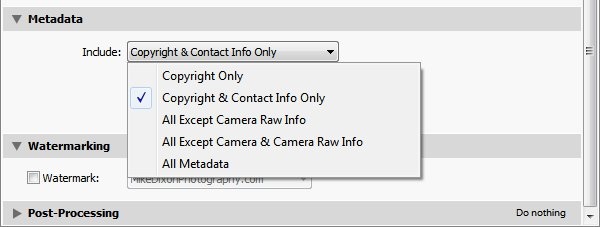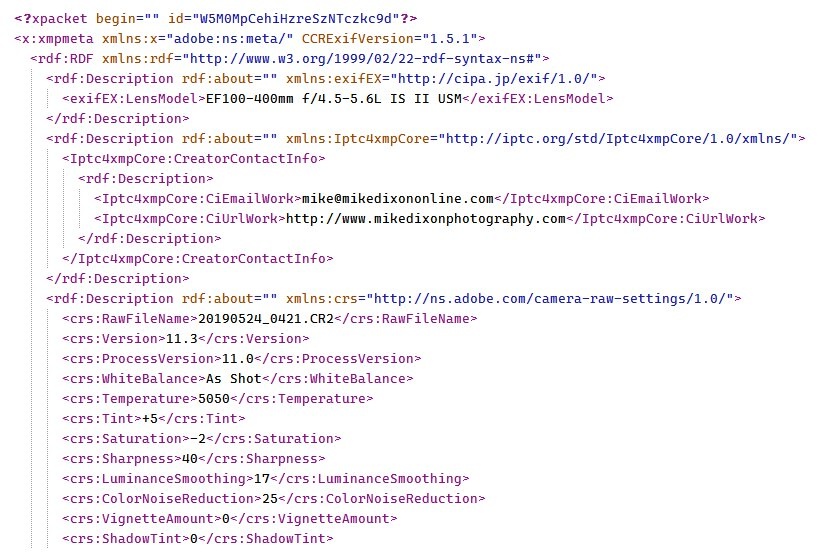All of your Lightroom development settings might be in your exported images. That's right, all of your adjustments, spot healings, tone curve adjustments, sharpening, etc. might all be in your exported files for all the world to see.
I recently had one of those truly WTF moments. I was working with a development library, reading and writing the various EXIF values of an image through code. I dropped one of my exported JPEG images on the program, and lo and behold, there was the XMP data of all my edits, even though I don't use XMP sidecar files.
What Is XMP?
XMP stands for Extensible Metadata Platform, a standard "for the creation, processing, and interchange of standardized and custom metadata for digital documents and data sets," as per Wikipedia.
The XMP file format is XML, which means that it is plain text. Human readable, formatted, plain text. This XMP information can be included inside TIFF, JPEG, PNG, GIF, PDF, and WEBP files or simply included as a separate sidecar file.
Lightroom, Photoshop, and other programs can read this information and apply those edits to an image. It's basically the same information that is inside a DNG file.
How Did It Get There?
The information was included in my export because I selected "All Metadata" in my export preset. Yes, this was a mistake on my part, but an understandable one. When you look at Lightroom's Metadata panel, you don't see development edits or adjustments. I wanted all the EXIF and IPTC information included, so I chose "All Metadata" when exporting the images.
The default export setting for metadata when creating an export preset depends on what preset you have selected, but if no preset is chosen when clicking "add," it usually defaults to "Copyright Only."
The Lightroom Export Dialog Metadata section includes the following options for what you want to include:
- Copyright Only
- Copyright & Contact Info Only
- All Except Camera Raw Info
- All Except Camera & Camera Raw Info
- All Metadata
The first two, "Copyright Only" and "Copyright & Contact Info Only," are self-explanatory. "All Except Camera Raw Info" and "All Except Camera & Camera Raw Info" would exclude the camera model and camera model/XMP, respectively. "All Metadata" includes everything, which is where I made a mistake.
The "Camera Raw Info" is the XMP information. I had assumed this meant the default EXIF information from the raw file, such as camera, lens, shutter speed, aperture, etc. In the words of Ron White: "I was wrong." I think Adobe should make this a bit more clear in the export dialog, as it's not exactly obvious.
Should You Really Care?
Most people may not care if anyone sees what they did to edit an image. Others may see it as a trade secret. Little things like what split toning you used or the fact that you added linear or circular gradients to the image may not be something you want to divulge to the whole world.
With the right software, you can even extract the XMP data to a file. I'm not sure if that data is in the correct format for use as a sidecar file, but it does make it easier to view. In the tests I did, there were a couple of differences in the format, but it was still readable to discern what edits were made to the image.
If you already have images that may have XMP data included in them and don't want it in there, there are various metadata stripper programs out there if you do a search. It is possible to strip the information from the file without having to re-export the photo.
I strive to learn new things every day, but this was not one of those things that I expected to surprise me! Is this just common knowledge, or have I helped you learn something today? Let me know in the comments!









Good info. Bad default by Adobe.
Yet another digital trail sprayed across the planet. Next your shampoo will record what you did in the shower.
However...you'd have to be fairly keen to poke inside somebody's images. Some bits of the metadata are obvious, but mostly it's pretty hard to know exactly what the changes were. So you changed the colour temperature? Not that interesting really.
Anyway, I wonder why Lightroom puts this in the file. Is it for edits when you next open it?
The only time I ever see this stuff is on Flickr because they are goofy enough to display it. If you don’t use Flickr, I wouldn’t be overly worried about anyone ever having seen your little secret if that mattered to you.
Every Browser has a extension or app to show EXIF info on mouse over.....
OMG people will find out that I used the exposure slider!!!!!
Sorry but the idea that your success as a photographer depends on keeping your Lightroom settings secret is beyond silly because....
1. Lightroom has a finite set of controls. Anyone could sit down and go through all the sliders to work out what they do and thus how to duplicate an effect, and
2. If they are too lazy to do that they just need to post a link in any of the many photo forums and a dozen people will tell them how it was done.
Its a bit tin foil hat brigade this one im afraid. I would taking someone wanting to know my 'editing secrets' as a compliment... but in reality they dont so im good haha.
This is good news. Are keywords exported? I don't want to do a lot of work adding keywords from inside of LR, since it is work lost if I should switch programs. Also I am on my third LR catalog restart. Can you wake up an exported file back into LR and have all your old edits in the history?
this is Old news.. its bin this why as far as i can remeber..
Very helpful. Thank you.
Your "mistake" was further upstream. There is a feature in Lightroom that allows you to optionally embed develop metadata in files (or XMP sidecars, as the case may be). The point of this is as a hedge against the day when that awful database becomes unavailable. The embedded information is just enough to recreate the last version of your edit. It's debatable whether this is a good idea or not. For sure, it takes up some space and in my opinion, it's unlikely to be very useful.
For the record, I use ON1 rather than Lightroom because all this stuff is just too kludgy for me.
Once you've got all those develop tags in your metadata, Lightroom doesn't offer a graceful way to get rid of them on export without destroying your caption. Which makes your photo Useless. To. Society. (Not to mention largely un-findable in your own archive.) If by chance there is a graceful way to remove the develop data within Lightroom before you export, I don't know it.
It's pretty easy to make it go away in Photo Mechanic: Take an IPTC snapshot; strip all XMP data; paste the IPTC snapshot back on your photo. You're left with only proper IPTC XMP fields. It's kind of a pain but it will do away with that bit of bloat.
If you can work at the command line, ExifTool (Don't be misled by the name. It's the big gun for all kinds of metadata work.) can surgically excise any problem metadata.
Yes, I do know good professional photographers who think that develop data or even Exif camera logging data constitutes some sort of trade secret that needs to be guarded. I think they are wound a bit tight. But to each his own.
I also know ninnies who think that whether they used 1/250 of a second or 1/320 is some sort of life-threatening privacy issue and that the software and camera companies are plotting against them. Those folks very seriously need to get a life.
I cover it in the article, just choose an export metdata option that doesn't include "camera raw info" in it and it won't put your develop settings in there. The EXIF information can still be included if you want, they're two separate things.
Ages ago when I ran a photo lab, if we suspected copyright issues (say, a bride right click/saved her album off the photogs gallery page) one of the tools we used to validate an image was: http://exif.regex.info/exif.cgi
It's interesting but the information isn't often useful on its own. If you are at all concerned about how your images are used (or pirated?) online exporting with at least your contact information and a copyright statement in EXIF improves your already slim chances of proving your ownership.
That said, I right clicked and saved several images from the F-Stopper 'featured photos' gallery (below) and about half don't have the 'artist' or 'copyright' fields filled out and many include nearly 100% of equipment data /camera settings plus instances of C1, PS, or LR adjustments.
F-stoppers - you might consider disabling right-click-to-copy on the site or at least in the gallery!